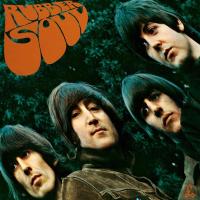Rubber Soul Reissue Rules!
They didn’t have much unrecorded material left and little if anything from their stage act upon which to draw. They began recording the Help! follow-up the second week of October, 1965 for an album that needed to be in the stores early December, but instead of a slapdash effort they produced Rubber Soul.
Out came “Norwegian Wood”, “Drive My Car,” “Day Tripper” and “We Can Work it Out” (the latter two needed for singles release), “If I Needed Someone”, “In My Life”, “I’m Looking Through You”, “Nowhere Man”, “Michelle”, “What Goes On”, “Think For Yourself”, The Word” and “Run For Your Life” (John hated it because the key, shocking for Beatles fare line “I’d rather see you dead little girl……” was lifted from a song Elvis Presley covered).
The singles were catchy pop tunes but many of the others were adult-themed, reflective and dug far deeper than had previous Beatles songs that targeted the preoccupations of adolescent girls.
According to Mark Lewisohn, at deadline time October 11th the album was short three songs. Paul and John each came up with one while “Wait”, a Help reject, was reworked until it was good enough to be added to the new album’s playlist. Paul’s contribution was “You Won’t See Me.” John’s was “Girl”, with its heavy sighs and ethnic feel.
While The Beatles were at Buckingham Palace getting their MBEs from Queen Elizabeth on October 26th, much of Rubber Soul was being mixed to stereo. The more critical, time-consuming mono mixes were never accomplished en masse.
The original stereo mixes of both Help and Rubber Soul so bothered George Martin that in 1986 he chose to remix them for the first Beatles CD releases. The original stereo mix pans hard left/right and has little to do with “stereo”. Unfortunately, though the remixes centered the vocals, they had reverb and other issues that left most listeners unhappy. Worse, the mix was done to 16 bit/44.1K “redbook” CD specifications, which meant that the stereo vinyl box set versions of Help! and Rubber Soul were essentially CDs transferred to lacquers.
You can listen to the original stereo mixes of both albums on the mono CD box set. While the vocal overdubs spread across the soundstage are enjoyable, the hard panning and arbitrary placement of the various mix elements makes a great case for the mono mix, though the mono mix itself makes a far better one!
Again this new mono all-analog vinyl release perfectly captures the tonal essence of the original and it destroys the mono CD, which sounds congealed and flat. If you have the mono CD set compare “Norwegian Wood” with the vinyl reissue. The acoustic guitar sounds dull, the bass soft and wooly. Even the cough at around 37 seconds, so clear and obvious on the vinyl is buried in the muck. Listen to Ringo’s finger cymbals. They hover in space sparking as they would played live in front of you. On the CD they are dull with no air around them. Try listening to the CD. See how many hard, metallic tracks you can listen to until you don’t care anymore.
Then play the record. The bottom end has plenty of weight but the notes play a tune and occupy a space. Paul’s voice is as spotlit and in places as harsh on the record as on the CD but the harshness occupies a space around his voice instead of infecting and splashing around on the mono stage. There’s just way more to listen to when the individual instruments and vocals are clearly defined in three-dimensional space and the high frequency transients sparkle naturally instead of sounding muffled.
Try “Michelle”. On the CD the background vocal harmonies blend into an indistinguishable mush. On the record the individual vocal elements are more easily identified. Paul’s vocal is out front in space and the roundness and dimensionalit of the image make it far more convincing. The simpler the production the more devastating the difference.
The original UK pressing and all of the original UK pressings by the way are cut at a hotter overall level so comparisons require level adjustment. At similar SPLs the original and reissue are remarkably close in terms of tonality but the original has a bit more midrange energy and “rational exuberance”. Again the tapes, though in great shape, do lose some energy as they age. All things considered this reissue is everything one could hope for. Beatle fans are lucky to have this reissue of one of the group’s best efforts. And again the pressing quality was perfect physically and sonically: quiet and flat. These are good looking records!



